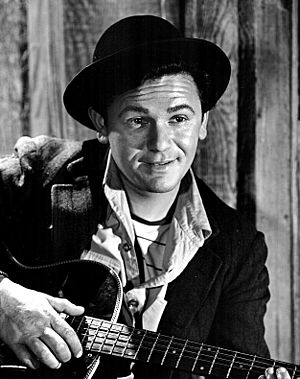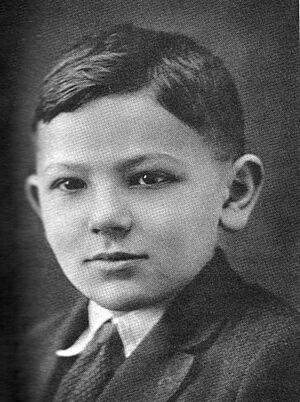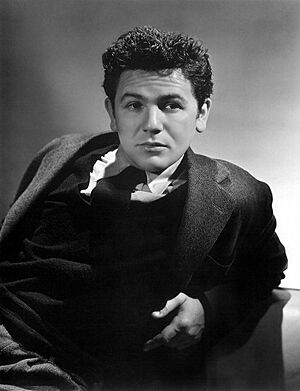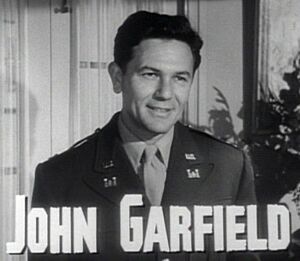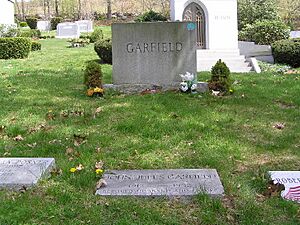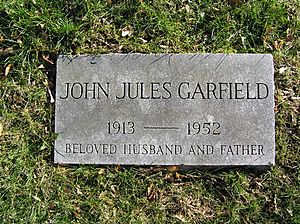John Garfield facts for kids
John Garfield (born Jacob Julius Garfinkle, March 4, 1913 – May 21, 1952) was a famous American actor. He was known for playing characters who were tough, rebellious, and from working-class backgrounds. John grew up in a poor neighborhood in New York City.
In the early 1930s, he joined a theater group called the Group Theatre. Later, in 1937, he moved to Hollywood and became a big star for Warner Bros.. He was even nominated for an Academy Award for his roles in Four Daughters (1938) and Body and Soul (1947).
John Garfield's career faced challenges when he was asked to testify before a U.S. government committee. He refused to name people who might have been involved in certain political groups. This decision sadly affected his film career. Many believe the stress from this time contributed to his early death at age 39. John Garfield is remembered as an actor who inspired later stars like Marlon Brando and James Dean.
Contents
Growing Up in New York City
Jacob Garfinkle was born in a small apartment in New York City. His parents, David and Hannah, were immigrants from Russia. He grew up in a lively area known for Yiddish theater. When he was very young, the middle name Julius was added, and his friends and family called him Julie.
His father worked hard as a clothes presser and a part-time singer in a synagogue. He struggled to earn enough money for his family. When John was five, his brother Max was born. Sadly, their mother passed away two years later. The young boys then lived with different relatives who were also poor. They moved around to different parts of New York City, like Brooklyn, Queens, and The Bronx.
John often missed school and had trouble reading and spelling. He later said that he learned "all the meanness, all the toughness" from growing up on the streets.
Finding His Way in School
When his father remarried, they moved to the West Bronx. John joined different street gangs there. He remembered that "Every street had its own gang. That's the way it was in poor sections." People started to notice that he was good at imitating famous performers. He also began to spend time at a boxing gym.
Around this time, he got scarlet fever, which caused lasting damage to his heart. This made him miss even more school. After being expelled from school three times, his father sent him to P.S. 45, a special school for kids who had trouble.
At this school, the principal, Angelo Patri, helped him discover acting. John had a slight stammer, so Patri sent him to a speech class. His teacher, Margaret O'Ryan, gave him acting exercises. She made him memorize and perform speeches in front of his class and then for school assemblies. She saw that he had a natural talent and cast him in school plays. She even encouraged him to join a citywide debating contest, where he surprisingly won second prize!
Learning to Act
With encouragement from his teachers, John started taking acting lessons at The Heckscher Foundation for Children. He began to appear in their plays. One day, a famous Yiddish actor named Jacob Ben-Ami saw him perform. He offered to help John and recommended him to the American Laboratory Theatre.
This theater was special because it taught a new way of acting called the "Method." This style focused on actors using their own feelings and experiences to make their characters real. John took morning classes and volunteered backstage, building sets and helping with shows. He felt this was the start of his acting journey. Many people who would become important in his career, like Stella Adler and Lee Strasberg, were also part of this theater group.
After working with other theater groups and even traveling across the country, John Garfield made his first appearance on Broadway in 1932. The play didn't last long, but it gave him his first important acting credit.
Joining the Group Theatre
John Garfield got a bigger role in his next play, Counsellor-at-Law, which starred Paul Muni. The play was very successful and even came back for a second run. At this time, the Warner Bros. studio in Hollywood became interested in John and wanted him to do a screen test. But he turned them down.
His friends, who he had met at the American Laboratory Theatre, started a new theater group called "the Group." John really wanted to join them. After trying for months, he finally got in as an apprentice.
A close friend of John's, Clifford Odets, wrote a play called Awake and Sing. John was cast as Ralph, a sensitive young son. The play opened in 1935, and critics praised John's acting. He became a full member of the Group Theatre. Odets even said he would write a play just for John called Golden Boy. However, another actor got the lead role, which made John feel disappointed. This made him start thinking about Hollywood again.
Becoming a Hollywood Star
Hollywood studios had tried to sign John before, but he always wanted a special part in his contract. He wanted to be able to take time off to do stage plays. This time, Warner Bros. agreed! So, John signed a seven-year contract with them. Many people in the Group Theatre were upset, feeling he had left them. But others, like Elia Kazan, thought it was good for him. The first thing Warner Bros. did was change his name to John Garfield.
After a few tries, he was cast in a very important supporting role in the film Four Daughters (1938). He played a sad young composer. When the movie came out, he received great reviews and was even nominated for an Academy Award for Best Supporting Actor. The studio quickly changed his contract, making him a major star. They then made a movie especially for him called They Made Me a Criminal (1939).
John's first big movie had a huge impact. He quickly became known for his unique acting style.
Challenges with the Studio
After his first big success, John Garfield often had disagreements with Warner Bros. The studio wanted him to act in popular dramas, but John wanted to choose roles that were more challenging and showed his different acting skills. This often led to him being suspended from work, meaning he wouldn't get paid if he refused a role. This was a common problem for actors working under the studio system back then.
One movie that was an exception was Daughters Courageous (1939). It had the same actors as Four Daughters but a different story. It was well-liked by critics.
Helping During World War II
When World War II began, John Garfield immediately tried to join the military. However, he was turned down because of his heart condition. Feeling frustrated, he put all his energy into supporting the war effort. He and actress Bette Davis helped open the Hollywood Canteen. This was a special club that offered food and entertainment for American soldiers.
He also traveled overseas to entertain the troops and helped sell war bonds. He starred in several patriotic movies that were very popular, like Air Force, Destination Tokyo (both 1943), and Pride of the Marines (1945). He was especially proud of Pride of the Marines, where he played a war hero who was blinded in combat. To prepare for this role, John lived with the real hero and his wife for several weeks and even blindfolded himself for hours to understand what it was like.
After the war, John Garfield starred in more successful films. These included The Postman Always Rings Twice (1946) with Lana Turner, Humoresque (1946) with Joan Crawford, and Gentleman's Agreement (1947). Gentleman's Agreement won an Oscar for Best Picture. In this film, John took a smaller role because he strongly believed in the movie's message about fighting antisemitism (prejudice against Jewish people) in America.
He was nominated for the Academy Award for Best Actor for his main role in Body and Soul (1947). In 1946, his contract with Warner Bros. ended, and John decided not to renew it. He chose to start his own independent film company instead.
The Red Scare and Its Impact
John Garfield had always been interested in liberal politics. In the late 1940s and early 1950s, America went through a period called the "Red Scare." During this time, there was a lot of fear about communism.
A government committee called the House Committee on Un-American Activities (HUAC) investigated people in Hollywood. When John was called to testify in 1951, he refused to name anyone he knew who might be involved in the Communist Party. He said he didn't know anyone in the film industry who was a member.
John Garfield did not support communism. Before he died, he even wrote an article saying he had been tricked by some communist ideas. However, his testimony before the committee seriously damaged his reputation. He was put on a blacklist, which meant Hollywood studios would not hire him for films anymore.
Because film work was hard to find, John returned to Broadway. In 1952, he starred in a new version of the play Golden Boy, finally getting the lead role he had wanted years before.
His Death
On May 9, 1952, John Garfield moved out of his New York apartment. He told friends he was separating from his wife, Roberta. Some friends thought it was because his wife didn't agree with an article he planned to write for Look magazine, where he would speak out against communism without naming names.
He was also worried that the HUAC committee might accuse him of lying in his past testimony. Three of his actor friends had recently died after being listed by the committee.
On the morning of May 20, John played several intense games of tennis, even though his doctor had told him not to. He also mentioned he hadn't slept the night before. Later that evening, he felt sick and went to bed at a friend's apartment. The next morning, he was found dead. He was only 39 years old. His death was caused by long-term heart problems, which many believed were made worse by the stress of being blacklisted.
His funeral was one of the largest in New York since Rudolph Valentino's, with thousands of people in the streets. John Garfield's money was left to his wife. Shortly after his death, the HUAC committee closed its investigation into him. John Garfield was buried at Westchester Hills Cemetery in New York.
Personal Life
John Garfield married Roberta Seidman in February 1935. They had three children:
- Katherine (1938 – 1945), who sadly died from an allergic reaction.
- David (1943–1994), who later became an actor.
- Julie (born 1946), who also became an actress.
Awards and Nominations
John Garfield was nominated for two Academy Awards:
- Academy Award for Best Supporting Actor for Four Daughters in 1939.
- Academy Award for Best Actor for Body and Soul in 1948.
He also has a star on the Hollywood Walk of Fame at 7065 Hollywood Boulevard.
Filmography
Feature Films
| Year | Title | Role |
|---|---|---|
| 1938 | Four Daughters | Mickey Borden |
| 1939 | They Made Me a Criminal | Johnnie Bradfield |
| 1939 | Daughters Courageous | Gabriel Lopez |
| 1941 | The Sea Wolf | George Leach |
| 1942 | Tortilla Flat | Daniel "Danny" Alvarez |
| 1943 | Air Force | Sgt. Joe Winocki |
| 1943 | Destination Tokyo | Wolf |
| 1945 | Pride of the Marines | Al Schmid |
| 1946 | The Postman Always Rings Twice | Frank Chambers |
| 1946 | Humoresque | Paul Boray |
| 1947 | Body and Soul | Charley Davis |
| 1947 | Gentleman's Agreement | Dave Goldman |
| 1948 | Force of Evil | Joe Morse |
| 1949 | We Were Strangers | Tony Fenner |
| 1950 | The Breaking Point | Harry Morgan |
| 1951 | He Ran All the Way | Nick Robey |
Images for kids
See also
 In Spanish: John Garfield para niños
In Spanish: John Garfield para niños


